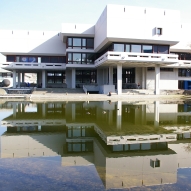Zusammenfassung
Previously, we identified ascorbic acid 6-O-hexadecanoate as an up to 1500 times more potent inhibitor of bacterial and bovine hyaluronidases than the parent compound, vitamin C, and determined a crystal structure of hyaluronidase from Streptococcus pneumoniae in complex with the inhibitor. As the alkanoyl chain interacts with a hydrophobic patch of the enzyme we synthesized other 6-O-acylated ...
Zusammenfassung
Previously, we identified ascorbic acid 6-O-hexadecanoate as an up to 1500 times more potent inhibitor of bacterial and bovine hyaluronidases than the parent compound, vitamin C, and determined a crystal structure of hyaluronidase from Streptococcus pneumoniae in complex with the inhibitor. As the alkanoyl chain interacts with a hydrophobic patch of the enzyme we synthesized other 6-O-acylated vitamin C derivatives bearing various lipophilic residues and investigated the inhibition of Streptococcus agalactiae strain 4755 hyaluronidase (SagHyal(4755)) and of bovine testicular hyaluronidases (BTH) in a turbidimetric assay. All compounds showed selectivity for the bacterial enzyme. Whereas vitamin C 6-O-hexanoate only weakly inhibited SagHyal(4755), the inhibition of both enzymes increased with the length of the aliphatic chain. In the case of the 6-O-octadecanoate, IC(50) values of 0.9 and 39microM for SagHyal(4755) and BTH, respectively, were determined. Partial replacement of the aliphatic chain with a phenyl, p-phenylene or p-biphenylyl group resulted in inhibitors with activity in the lower micromolar range, too. The title compounds are among the most potent inhibitors of both enzymes known to date.




 Altmetric
Altmetric